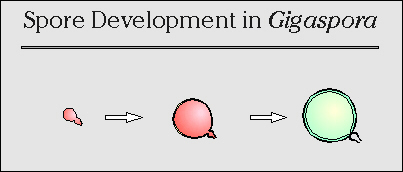Gigaspora Gerd. & Trappe
| Term | Description |
|---|---|
| Etymology: | Greek, “giant spore” |
| Description: | All known species produce spores without ornamentations. Spores consist of only a bilayered spore wall; germ tubes arise from a thin papillate (warty) layer arising from inner surface the laminate layer. Thin-walled auxiliary cells with echinulate surfaces, are produced on hyphae in the soil near the root surface. |
| Type species: | G. gigantea (Nicolson & Gerd.) Gerd. & Trappe |
Spore Ontogeny
Spores develop blastically from a hyphal tip, which swells and becomes the “sporogenous cell”. After the sporogenous cell reaches it’s full size (usually about 25-50 µm in most species), the spore begins to develop at the tip. The outer layer and the laminate layer develop simultaneously, and often cannot be distinguished in juvenile spores without the assistance of Melzer’s reagent. The laminae then thicken and ultimately develop the warty inner layer, from which multiple germ tubes arise. See Bentivenga and Morton (1995) for a description of spore development in the genus.
Literature Cited
- Bentivenga, S.P. and Morton, J.B. 1995. A monograph of the genus Gigaspora, incorporating developmental patterns of morphological characters. Mycologia 87: 720-732.
